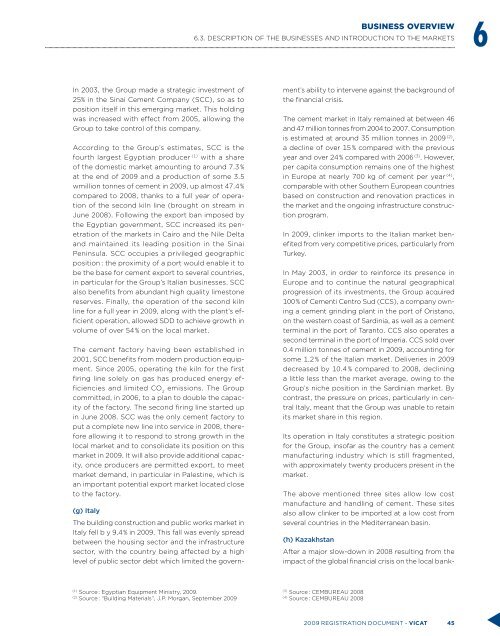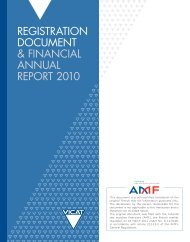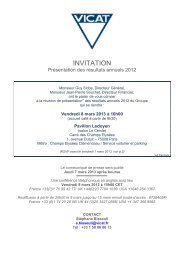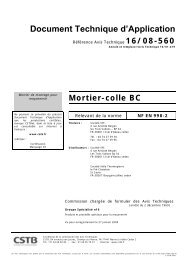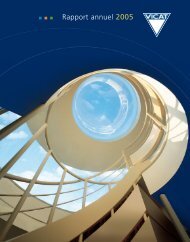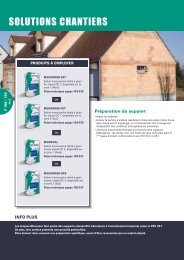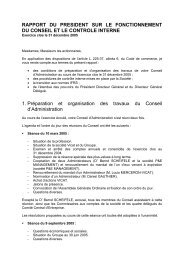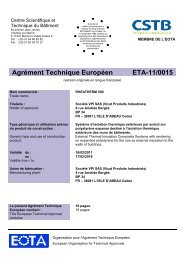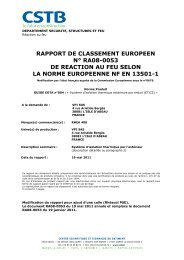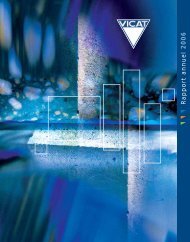6 - Vicat
6 - Vicat
6 - Vicat
- No tags were found...
Create successful ePaper yourself
Turn your PDF publications into a flip-book with our unique Google optimized e-Paper software.
BUSINESS OVERVIEW6.3. DESCRIPTION OF THE BUSINESSES AND INTRODUCTION TO THE MARKETS6In 2003, the Group made a strategic investment of25% in the Sinai Cement Company (SCC), so as toposition itself in this emerging market. This holdingwas increased with effect from 2005, allowing theGroup to take control of this company.According to the Group’s estimates, SCC is thefourth largest Egyptian producer (1) with a shareof the domestic market amounting to around 7.3 %at the end of 2009 and a production of some 3.5wmillion tonnes of cement in 2009, up almost 47.4 %compared to 2008, thanks to a full year of operationof the second kiln line (brought on stream inJune 2008). Following the export ban imposed bythe Egyptian government, SCC increased its penetrationof the markets in Cairo and the Nile Deltaand maintained its leading position in the SinaiPeninsula. SCC occupies a privileged geographicposition : the proximity of a port would enable it tobe the base for cement export to several countries,in particular for the Group’s Italian businesses. SCCalso benefits from abundant high quality limestonereserves. Finally, the operation of the second kilnline for a full year in 2009, along with the plant’s efficientoperation, allowed SDD to achieve growth involume of over 54 % on the local market.The cement factory having been established in2001, SCC benefits from modern production equipment.Since 2005, operating the kiln for the firstfiring line solely on gas has produced energy efficienciesand limited CO 2emissions. The Groupcommitted, in 2006, to a plan to double the capacityof the factory. The second firing line started upin June 2008. SCC was the only cement factory toput a complete new line into service in 2008, thereforeallowing it to respond to strong growth in thelocal market and to consolidate its position on thismarket in 2009. It will also provide additional capacity,once producers are permitted export, to meetmarket demand, in particular in Palestine, which isan important potential export market located closeto the factory.(g) ItalyThe building construction and public works market inItaly fell b y 9.4 % in 2009. This fall was evenly spreadbetween the housing sector and the infrastructuresector, with the country being affected by a highlevel of public sector debt which limited the government’sability to intervene against the background ofthe financial crisis.The cement market in Italy remained at between 46and 47 million tonnes from 2004 to 2007. Consumptionis estimated at around 35 million tonnes in 2009 (2) ,a decline of over 15 % compared with the previousyear and over 24 % compared with 2006 (3) . However,per capita consumption remains one of the highestin Europe at nearly 700 kg of cement per year (4) ,comparable with other Southern European countriesbased on construction and renovation practices inthe market and the ongoing infrastructure constructionprogram.In 2009, clinker imports to the Italian market benefitedfrom very competitive prices, particularly fromTurkey.In May 2003, in order to reinforce its presence inEurope and to continue the natural geographicalprogression of its investments, the Group acquired100 % of Cementi Centro Sud (CCS), a company owninga cement grinding plant in the port of Oristano,on the western coast of Sardinia, as well as a cementterminal in the port of Taranto. CCS also operates asecond terminal in the port of Imperia. CCS sold over0.4 million tonnes of cement in 2009, accounting forsome 1.2 % of the Italian market. Deliveries in 2009decreased by 10.4 % compared to 2008, declininga little less than the market average, owing to theGroup’s niche position in the Sardinian market. Bycontrast, the pressure on prices, particularly in centralItaly, meant that the Group was unable to retainits market share in this region.Its operation in Italy constitutes a strategic positionfor the Group, insofar as the country has a cementmanufacturing industry which is still fragmented,with approximately twenty producers present in themarket.The above mentioned three sites allow low costmanufacture and handling of cement. These sitesalso allow clinker to be imported at a low cost fromseveral countries in the Mediterranean basin.(h) KazakhstanAfter a major slow-down in 2008 resulting from theimpact of the global financial crisis on the local bank-(1)Source : Egyptian Equipment Ministry, 2009.(2)Source : “Building Materials”, J.P. Morgan, September 2009(3)Source : CEMBUREAU 2008(4)Source : CEMBUREAU 20082009 registration document - VICAT 45


